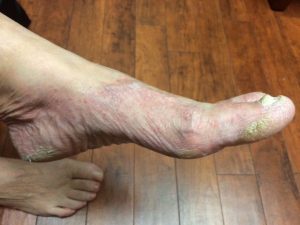Summary
A study lead by Lisa Christopher-Stine, M.D., M.P.H. identified “Hiker’s Feet” as a new skin finding in some patients with inflammatory muscle disease (myositis). This new finding may help to identify specific clinical subtypes of patients with myositis.
Why was this study done?
How was this study done?
Jacob and David, assisted by Dr. Christopher Mecoli and Dr. Arash Lahouti in the Divison of Rheumatology, lead efforts to systematically review records for all patients in the Johns Hopkins Myositis Center research database. They specifically looked for people with myositis in whom cracking or fissuring of the skin of the feet was observed. A cohort of 2145 myositis patient charts gathered since 2003 were reviewed looking for the key words “mechanic’s feet” and/or “mechanic’s foot.” Charts that included either phrase were further reviewed to determine the clinical characteristics of the patients. Nine people were identified with records that reported “mechanic’s feet” or “mechanic’s foot.”

Given that the term “mechanic’s feet’ was nonsensical, the researchers coined the term “hiker’s feet” to describe the clinical presentation that resembles a callousing pattern on the feet, more typical of avid hikers or long-distance walkers. Additional clinical information on patients with this characteristic skin abnormality was collected.
What were the major findings?
Of the 2145 charts reviewed, nine were identified as having hiker’s feet. All nine affected individuals carried a diagnosis of dermatomyositis, and seven also met criteria for having antisynthetase syndrome. Mechanic’s hands was also observed in eight of these patients (89%). Six (67%) presented with anti-Jo-1 antibodies, a biomarker that is associated with myositis, and three (33%) were negative for any known myositis-specific antibody biomarkers.
What is the impact of this work?
Given that the presence of hiker’s feet was not systematically looked for as patients were seen in the clinic, the true prevalence of this new skin finding is not yet known. This is an important topic for future study. It is critical to note that the presence of hiker’s feet alone does not indicate the presence of myositis, but should be considered in the context of other symptoms. If the presenting signs of myositis are expanded to include hiker’s feet, it could aid in diagnosis and management, as well as provide insights into understanding how and why people develop this disease.
This research was supported by:
The Huiayi and Siuling Zhang Discovery Fund.
Link to original research article:
“Hiker’s feet”: a novel cutaneous finding in the inflammatory myopathies. Cox JT, Gullotti DM, Mecoli CA, Lahouti AH, Albayda J, Paik J, Johnson C, Danoff SK, Mammen AL, Christopher-Stine L. Clin Rheumatol. 2017 Apr 7.


